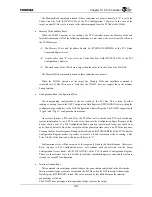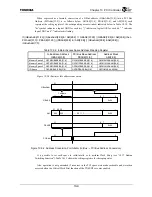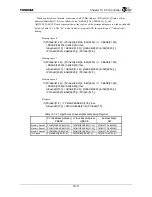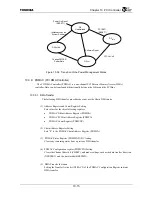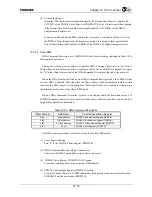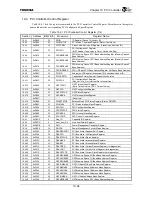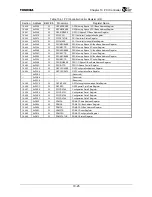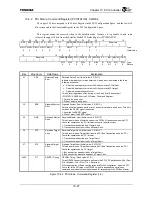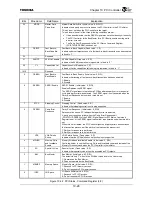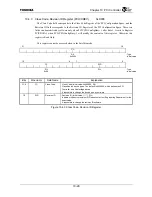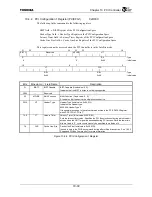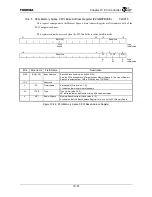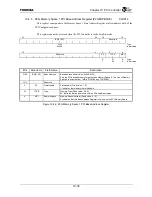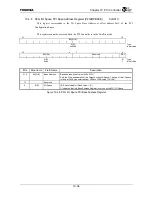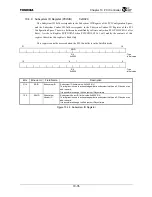
Chapter 10 PCI Controller
10-20
10.3.10.4 Error Detection Interrupts
Name
Status Bit
Interrupt Enable Bit
Bus Error Detection
DPE
DPEIE
System Error Signal
SSE
SSEIE
Master Data Parity Error
PCISTATUS
/
PCISSTATUS
MDPE
PCIMASK
MDPEIE
Master Direct Fatal Error
MDFE
MDFEIE
Master Direct Parity Error
MPRE
MPREIE
TRDY Timeout Error
IDTTOE
IDTTOEIE
Retry Timeout Error
G2PSTATUS
IDRTOE
G2PMASK
IDRTOEIE
Broken Master Detection
PBASTATUS
BMD
PBAMASK
BMDIE
Target PERR
*
Detection
PERR
PERRIE
Target G-bus Error Detection
P2GSTATUUS
GBE
P2GMASK
GBEIE
SERR
*
Detection
PCICSTATUS
SERR
PCICMASK
SERRIE
Note: In the initiator write cycle, access on the G-Bus has been finished before access on
the PCI bus is finished (Post write). Therefore, when an error occurs on PCI bus, it is
reported with an error detection interrupt, as shown above. In the initiator read cycle,
when an error occurs on the PCI bus access, PCIC responds with a G-Bus error
instead of returning read data to the G-Bus. Setting "0" to the IRBER bit of the
"G2PCFG" register suppresses output of a G-Bus error during initiator read.
10.3.11 PCI Bus Arbiter
Configuration settings (ADDR[1] signal = “1”) during boot up selects whether to use the on-chip PCI
Bus arbiter (Internal PCI Bus Arbiter mode) or to use the External PCI Bus arbiter (External PCI Bus
Arbiter mode).
When in the Internal PCI Bus Abiter mode, setting the PCI Bus Arbiter Enable bit
(PBACFG.PBAEN) of the PCI Bus Arbiter Configuration Register starts operation.
The on-chip PCI Bus arbiter can arbitrate eight sets of PCI Bus usage requests from the Bus Master.
Five ports are used: one for the PCI Controller bus master and four for External Bus masters. The three
remaining ports are reserved for future expanded features.
10.3.11.1 Request Signal, Grant Signal
The four external Bus Masters are connected to the REQ[3:0] signal and the GNT[3:0]* signal.
Also, when in the External PCI Bus Arbiter mode (Satellite Mode), the REQ[0]* signal
becomes the PCI Bus Request Output signal and the GNT[0]* signal becomes the Bus Usage
Permission Input Signal. Furthermore, the REQ[1]* signal can be used as an interrupt output
signal to the external devices (see 15.3.7 for more information).
Содержание TMPR4925
Страница 1: ...64 Bit TX System RISC TX49 Family TMPR4925 Rev 3 0 ...
Страница 4: ......
Страница 15: ...Handling Precautions ...
Страница 16: ......
Страница 18: ...1 Using Toshiba Semiconductors Safely 1 2 ...
Страница 40: ...3 General Safety Precautions and Usage Considerations 3 18 ...
Страница 42: ...4 Precautions and Usage Considerations 4 2 ...
Страница 43: ...TMPR4925 ...
Страница 44: ......
Страница 54: ...Chapter 1 Features 1 8 ...
Страница 58: ...Chapter 2 Block Diagram 2 4 ...
Страница 88: ...Chapter 4 Address Mapping 4 12 ...
Страница 226: ...Chapter 8 DMA Controller 8 58 ...
Страница 260: ...Chapter 9 SDRAM Controller 9 34 ...
Страница 480: ...Chapter 15 Interrupt Controller 15 32 ...
Страница 554: ...Chapter 19 Real Time Clock RTC 19 8 ...
Страница 555: ...Chapter 20 Removed 20 1 20 Removed ...
Страница 556: ...Chapter 20 Removed 20 2 ...
Страница 564: ...Chapter 21 Extended EJTAG Interface 21 8 ...
Страница 580: ...Chapter 22 Electrical Characteristics 22 16 ...
Страница 586: ...Chapter 23 Pin Layout Package 23 6 23 2 Package Package Type Package Code 256 pin PBGA PBGA 4L P BGA256 2727 1 27A4 ...
Страница 588: ...Chapter 24 Usage Notes 24 2 ...
Страница 590: ...Appendix A TX49 H2 Core Supplement A 2 ...


